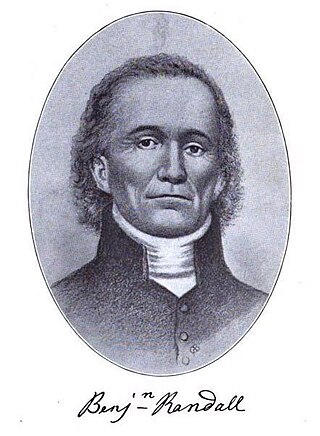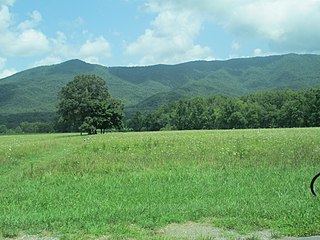
The Church of God, with headquarters in Cleveland, Tennessee, United States, is an international Holiness-Pentecostal Christian denomination. The Church of God's publishing house is Pathway Press.
Two-Seed-in-the-Spirit Predestinarian Baptists are part of a larger sub-group of Baptists that is commonly referred to as "anti-mission" Baptists. This sub-group includes the Duck River and Kindred Baptists, Old Regular Baptists, some Regular Baptists and some United Baptists. Only a minuscule minority of Primitive Baptists adhere to the Two-Seed doctrine. The primary centers of Two-Seedism were in Northern Alabama, Arkansas, Eastern Tennessee, Florida, Georgia, Illinois, Indiana, and Texas. As of 2002, five churches or congregations of this faith and order still existed in Alabama, Indiana, Tennessee, and Texas.
Primitive Baptists – also known as Regular Baptists, Old School Baptists, Foot Washing Baptists, or, derisively, Hard Shell Baptists – are conservative Baptists adhering to a degree of Calvinist beliefs who coalesced out of the controversy among Baptists in the early 19th century over the appropriateness of mission boards, tract societies, and temperance societies. Primitive Baptists are a subset of the Calvinistic Baptist tradition. The adjective "primitive" in the name is used in the sense of "original".
The Old Regular Baptist denomination is one of the oldest in Appalachia with roots in both the Regular and Separate Baptists of the American Colonies and the Particular Baptist of Great Britain. This group has seen a marked decline in its membership during the last two decades. Part of the decline may be attributable to orthodox biblical interpretations like a dress code where men must wear long pants, not shorts, and women must wear long dresses. Other such interpretations include women not being allowed to cut their hair or speak publicly on church business, although women can frequently shout while praising. Members who do not comply with the strict dress code and norms face being "churched", i.e., being kicked out of the congregation and possibly shunned. The Old Regular Baptist Faith and order with her many branches and factions still remains the dominant Faith in some rural Central Appalachian Counties along or near the Kentucky Virginia border. In most churches, the congregation maintains a collection of photographs of deceased members.

Free Will Baptists or Free Baptists are a group of General Baptist denominations of Christianity that teach free grace, free salvation and free will. The movement can be traced to the 1600s with the development of General Baptism in England. Its formal establishment is widely linked to the English theologian, Thomas Helwys who led the Baptist movement to believe in general atonement. He was an advocate of religious liberty at a time when to hold to such views could be dangerous and punishable by death. He died in prison as a consequence of the religious persecution of Protestant dissenters under King James I.
The Separate Baptists are a group of Baptists originating in the 18th-century United States, primarily in the South, that grew out of the Great Awakening.
Union Baptists is a Baptist Christian denomination in United States.

Joshua Lawrence (1778–1843), of Tarboro, North Carolina, was an influential Baptist minister in the eastern United States during the Baptist missions controversy in the early 19th century.
John Taylor (1752–1833) was a pioneer Baptist preacher, religious writer, frontier historian and planter in north and central Kentucky. His two histories of early Baptist churches in Kentucky provide insight into the frontier society of the early decades of the 19th century. His 1820 pamphlet entitled "Thoughts on Missions" put him at the center of the controversy within frontier Baptist congregations about supporting mission societies. In buying and selling land on the frontier, Taylor acquired 2,000 acres (8.1 km2) and 20 African-American slaves by the end of the first decade of the 19th century, thus entering the planter class.

The camp meeting is a form of Protestant Christian religious service originating in England and Scotland as an evangelical event in association with the communion season. It was held for worship, preaching and communion on the American frontier during the Second Great Awakening of the early 19th century. Revivals and camp meetings continued to be held by various denominations, and in some areas of the mid-Atlantic, led to the development of seasonal cottages for meetings.

Cades Cove is an isolated valley located in the Tennessee section of the Great Smoky Mountains National Park. The valley was home to numerous settlers before the formation of the national park. Cades Cove, the single most popular destination for visitors to the park, attracts more than two million visitors annually because of its well preserved homesteads, scenic mountain views, and abundant display of wildlife. The Cades Cove Historic District is listed on the National Register of Historic Places.
Shubal Stearns, was a colonial evangelist and preacher during the Great Awakening. He converted after hearing George Whitefield and planted a Baptist Church in Sandy Creek, Guilford County, North Carolina. Stearns' highly successful ministry was related to the rise and expansion of the Separate Baptists — especially in much of the American South.
Morgan Edwards was an American historian of religion and Baptist pastor. He was a trustee in the chartering of the College in the English Colony of Rhode Island and Providence Plantations, later named Brown University.
Martha Stearns Marshall (1726–1771) was a Separate Baptist preacher in the Southern United States. She spread the gospel alongside her husband, Daniel Marshall (1706–84), who is generally regarded as the first great Baptist leader in the state of Georgia. Her husband was once jailed in Virginia for refusing to stop preaching the gospel. Although she was three months pregnant at the time, she exhorted those around that it was wrong to forbid a man to preach the Biblical truth of baptism. Her words convicted a young man named Cartledge and he became a preacher; she also converted the arresting constable and magistrate. She often stood alongside her brother Shubal Stearns and spoke at Baptist meetings. Martha also assisted her husband Daniel in his churches. She gave birth to six sons and two daughters.

Cullen Andrews Battle was an American attorney, farmer, and politician. He was a general in the Confederate States Army during the American Civil War. He fought Congressional Reconstruction after the war in Alabama then North Carolina.

Needham Bryant Broughton was an American printer, temperance activist, and politician who served as a North Carolina state senator from 1901 to 1903. He co-owned a prosperous printing business, Edwards & Broughton, and was a member of several commercial organizations. An active member in the North Carolina Baptist community, he served as secretary of the Southern Baptist Convention for approximately 30 years. Broughton was born in 1848 near Auburn, North Carolina. Eight years later his family moved to Raleigh, and he enrolled in public school. After several years of work in printing offices which saw him employed in Washington, D.C., and New York City, Broughton returned to Raleigh and married. In 1872 he and C.B. Edwards established the Edwards & Broughton Printing Company. It quickly became one of the largest printers in North Carolina, and for a time it did most of the printing and binding of state publications.
The Baptist State Convention of North Carolina (BSCNC) is an autonomous association of Baptist churches in the state of North Carolina. It is one of the state conventions associated with the Southern Baptist Convention. Headquartered in Cary, North Carolina, the convention is made up of 77 Baptist associations and around 4,300 churches as of 2012. The convention is led by three officers, elected annually during the annual meeting of the convention. The convention is also led by an Executive Director-Treasurer (EDT). The current EDT is Rev. Todd Unzinger, who was elected by the convention in May 2021.

Liberty Universalist Church and Feasterville Academy Historic District is a national historic district located near Winnsboro, Fairfield County, South Carolina. The property encompasses four buildings constructed between 1831 and 1845. They are the Liberty Universalist Church and three buildings associated with the Academy: a boarding house, a kitchen, and a school building. The buildings were constructed by the Feaster family.
Pleasant Daniel Gold was an American publisher, lawyer, and Baptist minister. Ordained as a Primitive Baptist minister in the Kehukee Association, he was a prominent Baptist leader in North Carolina for over half-a-century. He served as a minister in Rocky Mount, Goldsboro, Wilson, Tarboro, and Durham. In 1867 he co-founded the Baptist newspaper Zion's Landmark, serving as editor until 1920. In 1902 he founded the P.D. Gold Publishing Company, which issued two newspapers for Wilson County.











